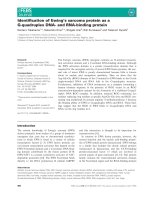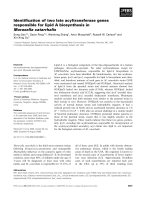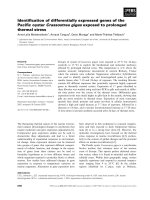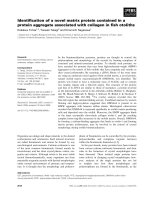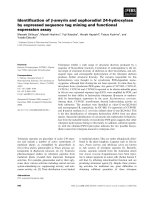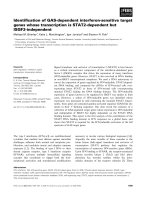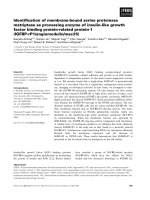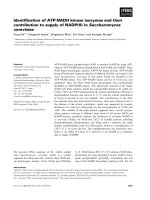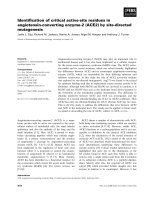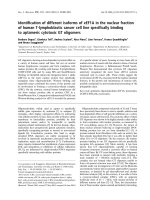Báo cáo khoa học: Identification of carbonic anhydrase 9 as a contributor to pingyangmycin-induced drug resistance in human tongue cancer cells ppt
Bạn đang xem bản rút gọn của tài liệu. Xem và tải ngay bản đầy đủ của tài liệu tại đây (520.84 KB, 13 trang )
Identification of carbonic anhydrase 9 as a contributor to
pingyangmycin-induced drug resistance in human tongue
cancer cells
Guopei Zheng
1,
*, Min Zhou
1,
*, Xinrong Ou
2
, Bo Peng
1
, Yanhui Yu
1
, Fangren Kong
1
,
Yongmei Ouyang
1
and Zhimin He
1
1 Cancer Research Institute, Xiangya School of Medicine, Central South University, Changsha, Hunan, China
2 Department of Stomatology, Xiangya Hospital, Central South University, Changsha, Hunan, China
Introduction
Squamous cell carcinoma of the head and neck is the
fifth most common cancer worldwide, and is a signifi-
cant source of cancer morbidity and mortality. More
than 500 000 new cases are estimated to occur world-
wide every year [1,2]. Tongue cancer is the most com-
mon type of squamous cell carcinoma of the head and
Keywords
CA9; cDNA microarray; drug resistance;
pingyangmycin; tongue cancer
Correspondence
Zhimin He, Cancer Research Institute,
Xiangya School of Medicine, Central South
University, Xiangya Road #110, 410078
Changsha, Hunan, China
Fax: +86 0731 82355043
Tel: +86 0731 82355041
E-mail:
*These authors contributed equally to this
work
(Received 20 June 2010, revised 6 August
2010, accepted 31 August 2010)
doi:10.1111/j.1742-4658.2010.07836.x
Drug resistance is the major obstacle to successful cancer treatment. To
understand the mechanisms responsible for drug resistance in tongue can-
cer, Tca8113 cells derived from moderately differentiated human tongue
squamous cell carcinoma were exposed to stepwise escalated concentrations
of pingyangmycin (PYM) to develop the resistant cell line called Tca8113⁄
PYM, which showed over 18.78-fold increased resistance to PYM as
compared with Tca8113 cells, and cross-resistance to cisplatin, pirarubicin,
paclitaxel, adriamycin, and mitomycin. We found that the resistance was
not associated with multidrug resistance transporter 1 (p170, p-gp), multi-
drug resistance-associated protein 1 and breast cancer resistance protein
overexpression, so we hypothesized that Tca8113 ⁄ PYM cells must have
some other resistance mechanism selected by PYM. To test this hypothesis,
the global gene expression profiles between Tca8113 and Tca8113 ⁄ PYM
cells were compared by cDNA microarray. Eighty-nine genes and thirteen
expressed sequence tags with differential expression levels between the two
cell lines were identified. Some differential expression levels were validated
with real-time PCR and western blot. Furthermore, the functional valida-
tion showed that both carbonic anhydrase (CA) inhibitor acetazolamide
application and CA9 silencing with CA9 antisense oligonucleotides contrib-
ute to the medium pH increase of Tca8113 ⁄ PYM cells and enhanced PYM
chemosensitivity. Moreover, both acetazolamide and CA9 antisense oligo-
nucleotides significantly increased PYM-induced caspase 3 activation in
Tca8113 ⁄ PYM cells. Thus, our study suggests that the resistance of
Tca8113 ⁄ PYM cells is probably associated with CA9 and other differential
expression molecules, and that CA9 may be an important marker for pre-
diction of PYM responsiveness in tongue cancer chemotherapy.
Abbreviations
ADM, adriamycin; ASO, antisense oligonucleotide; Atz, acetazolamide; BCRP, breast cancer resistance protein; BMP2, bone morphogenetic
protein 2; CA, carbonic anhydrase; cDDP, cisplatin; DKK1, dickkopf homolog 1; EST, expressed sequence tag; HIF, hypoxia-inducible factor;
MDR, multidrug resistance; MDR1, multidrug resistance transporter 1 (p170, p-gp); MMC, mitomycin; MRP1, multidrug resistance-
associated protein 1; MT, metallothionein; MTT, 3-(4,5-dimethylthiazol-2-yl)-2,5-diphenyl-tetrazolium bromide; PARP, poly(ADP-ribose)
polymerase; pHe, extracellular pH; pHi, intracellular pH; pNA, p-nitroaniline; PYM, pingyangmycin; VP-16, etoposide; 5-FU, fluorouracil.
4506 FEBS Journal 277 (2010) 4506–4518 ª 2010 The Authors Journal compilation ª 2010 FEBS
neck, and the incidence is increasing every year. It is
found to be rapidly progressing, to frequently metasta-
size, and to have a poorer prognosis than carcinoma
of other sites in the oral cavity [3]. Chemotherapy
plays a very important role in tongue cancer treatment,
especially for patients who are detected at a late stage
or have potential recurrence after surgical procedures.
The benefits of chemotherapy include reduction of the
distant metastasis rate, improved survival rate, and
preservation of organ function, whether or not com-
bined with local ⁄ regional treatment [4]. In the clinic,
pingyangmycin (PYM), cisplatin (cDDP) and fluoro-
uracil (5-FU) are mostly used in chemotherapy of ton-
gue cancer, but the effectiveness of monotherapy with
PYM for preoperative chemotherapy is only about
67% [5,6]. Moreover, the therapeutic benefits of che-
motherapy can be attenuated because of intrinsic
and ⁄ or acquired drug resistance, especially multidrug
resistance (MDR). ATP-binding cassette transporters
such as MDR transporter 1 (p170, p-gp) (MDR1) have
been reported in some primary tongue squamous cell
carcinomas, and they are chemotherapy-inducible,
showing relevance to drug resistance [7]. Accumulating
evidence suggests that multiple complex mechanisms
may be involved, simultaneously or complementarily,
in the emergence and development of drug resistance
in cancers. Although some advances in cancer drug
resistance research have been made, indicating that
ATP-binding cassette transporters play important roles
in cancer drug resistance but cannot fully explain the
resistance phenomenon, there are still only a few stud-
ies focusing on tongue cancer.
PYM, a water-soluble glycopeptide produced by
Streptomyces pingyangensin, is a new type of cytotoxic
glycopeptide antitumor antibiotic developed in China
in the 1980s. It is a member of the bleomycin family,
and is also known as bleomycin A5. It has been found
to reduce the DNA synthesis of cancer cells and cut
off the DNA chain [8]. With its wide antitumor spec-
trum and lower toxicity in chemotherapy of malignant
tumors [9], PYM plays a particular curative role in
chemotherapy for treatment of squamous cell carci-
noma, malignant lymphoma, Hodgkin’s disease, and
lymphangioma [10]. It is fairly extensively used in che-
motherapy for the treatment of neoplasms in the head
and neck region [10]. However, the therapeutic benefits
of PYM can be attenuated in the clinic, because of
intrinsic and ⁄ or acquired drug resistance, which is the
major limitation of PYM-based chemotherapy.
The mechanism of cellular resistance to PYM is not
fully understood, but it is extremely important to
understand it for successful treatment of tongue carci-
noma. In this study, we established a cellular model,
Tca8113 ⁄ PYM cells, with acquired resistance induced
by PYM, expecting to reveal new molecules related to
PYM resistance, and to provide candidate biomarkers
to predict the clinical response to PYM-based chemo-
therapy in tongue cancers.
Results
Biological characteristics of Tca8113
⁄
PYM cells
In order to explore the mechanism responsible for PYM
resistance in tongue cancer, in the first step of the pres-
ent study we established a PYM-resistant cell line,
Tca8113 ⁄ PYM. The Tca8113 ⁄ PYM cell line was
obtained by stepwise selection from its sensitive parent
cell line with PYM over a period of 2 years. At the
beginning of induction, cell growth was strongly sup-
pressed. However, at the end of induction, Tca8113 ⁄
PYM cells exhibited a stable growth pattern in medium
with 0.2 mgÆL
)1
PYM. After further maintenance for
5 weeks in PYM-free medium, the mean population
doubling time was found to be 35.76 ± 4.62 h for
Tca8113 ⁄ PYM cells, as compared with 35.12 ± 4.18 h
for Tca8113 cells (no statistically significant difference;
P > 0.05) (Fig. 1A). After cells had been treated with
different concentrations of PYM from 0 to 800 mgÆL
)1
for 48 h, dose–response curves were plotted, as shown in
Fig. 1B. The IC50 values for PYM treatment in
Tca8113 and Tca8113 ⁄ PYM cells were 27.16 ± 1.78
mgÆL
)1
and 509.47 ± 37.71 mgÆL
)1
, respectively (P <
0.01). The resistance index was 18.78, indicating that the
PYM-resistant cell line was successfully established.
The antiapoptotic activity of Tca8113⁄ PYM cells
was also measured with Hoechst33258 stain (Fig. 1C).
Twenty-four hours after treatment with 300 mgÆL
)1
PYM, despite increased numbers of apoptotic cells,
typically identified as those cells that possess signifi-
cantly smaller, condensed and fragmented nuclei under
a fluorescence microscope, in both cell lines, the rate
of apoptosis in Tca8113 cells was much higher than
that in Tca8113 ⁄ PYM cells: 88.10± 7.96% and
15.86± 2.75%, respectively (P < 0.01).
In addition, in order to determine whether the
resistance was associated with the overexpression of
well-documented resistance-related molecules MDR1,
multidrug resistance-associated protein 1 (MRP1), and
breast cancer resistance protein (BCRP), RT-PCR was
performed (Fig. 1D). There was no significant differ-
ence in MDR1 or BCRP mRNA level between
Tca8113 and Tca8113 ⁄ PYM cells, and there was no
detectable expression of MRP1, indicating that resis-
tance to PYM may be associated with some other mole-
cules.
G. Zheng et al. Role of CA9 in PYM resistance
FEBS Journal 277 (2010) 4506–4518 ª 2010 The Authors Journal compilation ª 2010 FEBS 4507
Cross-resistance profiles of Tca8113
⁄
PYM cells
The sensitivities of both cell lines to cDDP, piraru-
bicin, paclitaxel, mitomycin (MMC), adriamycin
(ADM), etoposide (VP-16) and 5-FU were determined
by 3-(4,5-dimethylthiazol-2-yl)-2,5-diphenyl-tetrazolium
bromide (MTT) assay, and the IC50 for each agent
was calculated. Both cell lines were treated with differ-
ent concentrations of each agent, and the IC50 values
are summarized in Table 1. The results revealed
Tca8113 ⁄ PYM cells showed resistance to cDDP, pira-
rubicin, paclitaxel, ADM and MMC, but not to VP-16
or 5-FU, indicating that Tca8113 ⁄ PYM was a typical
MDR model, and that studies on the mechanism of
resistance in this cell line have potential significance.
Differential gene expression profiles between
Tca8113
⁄
PYM and Tca8113 cells
Because there were no differences in expression of the
well-known resistance-related genes MDR1, MRP1 or
BCRP, to identify genes generally involved in PYM
A
B
C
D
Cell number/well (×10
4
)Inhibition rate (%)
Concentration of PYM (mg·L
–1
)
Days
Fig. 1. Biological characteristics of Tca8113 ⁄ PYM cells. (A) Growth
curves for both cell lines were obtained in three independent exper-
iments, and showed no difference in the mean doubling time. (B)
Responses of Tca8113 and Tca8113 ⁄ PYM cells to PYM. Tca8113 ⁄
PYM cells were more resistant to the antiproliferative activity of
PYM. Each point represents the mean of six independent experi-
ments. (C) The effects of PYM-induced apoptosis on both cell lines
were observed with Hoechst33258 stain. The results represent
three independent experiments, and show that Tca8113 ⁄ PYM cells
are much more resistant to PYM-induced apoptosis. (D) Relative
mRNA expression levels of MDR1, MRP1 and BCRP between both
cell lines after normalization to b-actin mRNA levels were deter-
mined by RT-PCR. RT-PCR analysis was repeated three times, and
showed no significant expression difference between the two cell
lines for MDR1 or BCRP, and no detectable expression of MRP1.
Table 1. IC50 values (mgÆL
)1
) for selected agents (mean ± stan-
dard deviation, n = 3). The results show MDR characteristic of
Tca8113 ⁄ PYM cells. RI, resistance index, representing IC50
Tca8113 ⁄
PYM
⁄ IC50
Tca8113
.
Agent Tca8113 Tca8113 ⁄ PYM RI
PYM 27.16 ± 1.78 509.47 ± 37.71** 18.78
cDDP 2.27 ± 0.50 7.92 ± 0.60** 3.49
Paclitaxel 11.07 ± 1.63 23.68 ± 3.63* 2.14
MMC 0.32 ± 0.03 0.64 ± 0.15* 1.99
Pirarubicin 3.33 ± 0.55 6.72 ± 0.87* 1.88
ADM 0.48 ± 0.14 0.87 ± 0.14* 1.81
VP-16 17.50 ± 6.21 27.29 ± 8.73 1.56
5-FU 10.68 ± 2.54 10.78 ± 2.39 1.01
**P < 0.01 and *P < 0.05 versus Tca8113.
Role of CA9 in PYM resistance G. Zheng et al.
4508 FEBS Journal 277 (2010) 4506–4518 ª 2010 The Authors Journal compilation ª 2010 FEBS
resistance we compared gene expression profiles
between Tca8113 ⁄ PYM and Tca8113 cells by cDNA
microarray. We excluded genes whose expression was
increased or decreased by less than two-fold in PYM-
resistant cells (as compared with the parent cells). A
total of 89 genes were selected, among which 41 genes
were upregulated (Table 2) and 48 genes were down-
regulated (Table 3) in the Tca8113 ⁄ PYM cell line. In
addition, 13 expressed sequence tags (ESTs) were also
selected, four of which were upregulated and nine of
which were downregulated (Table 4). Interestingly, in
our microarray data, there were also no significant dif-
ferences in expression of MDR1, MRP1 or BCRP
between these two cell lines, in agreement with the
results of RT-PCR, so we considered that the resis-
tance may be related to a number of other differential
genes associated with a variety of cellular functions,
such as those encoding carbonic anhydrase (CA) 9,
metallothionein (MT) 2A, bone morphogenetic pro-
tein 2 (BMP2), and dickkopf homolog 1 (DKK1).
Table 2. Genes with upregulated expression in Tca8113 ⁄ PYM cells.
No. Gene name GenBank ID Ratio Gene product
1 CA9 NM_001216 4.993 Carbonic anhydrase 9
2 BMP2 NM_009309 4.933 Bone morphogenetic protein 2
3 PARN NM_002582 3.644 Poly(A)-specific ribonuclease
4 LYPD3 NM_014400 3.208 LY6 ⁄ PLAUR domain containing 3
5 ITPR1 NM_002222 2.98 Inositol 1,4,5-trisphosphate receptor, type 1
6 MT2A NM_175617 2.955 Metallothionein 2A
7 ITGA5 NM_002205 2.881 Integrin a
5
precursor
8 NOL5A NM_006392 2.71 Nucleolar protein 5A (56 kDa with KKE ⁄ D repeat)
9 SDC4 NM_002999 2.623 Syndecan 4 (amphiglycan, ryudocan)
10 C20orf139 NM_080725 2.621 Sulfiredoxin-1
11 PPP2R2B NM_004576 2.618 b-Isoform of regulatory subunit B55, protein phosphatase 2 isoform a
12 ITGB5 NM_002213 2.604 Integrin b
5
13 METRN NM_024042 2.546 Meteorin, glial cell differentiation regulator
14 NOL5A NM_006392 2.524 Nucleolar protein 5A (56 kDa with KKE ⁄ D repeat)
15 EIF4G1 NM_182917 2.386 Eukaryotic translation initiation factor 4c,1
16 MAN1B1 NM_016219 2.382 a-1,2-Mannosidase
17 ENO2 NM_001975 2.377 Enolase 2
18 DDIT4 NM_019058 2.371 RTP801
19 SGK NM_005627 2.353 Serum ⁄ glucocorticoid-regulated kinase
20 TSC22D1 NM_183422 2.307 TSC22 domain family, member 1
21 NCBP2 NM_007362 2.277 Nuclear cap-binding protein subunit 2
22 RUVBL1 NM_003707 2.268 Similar to RuvB (E. coli homolog)-like 1
23 HNRPAB NM_031266 2.258 Homo sapiens heterogeneous nuclear ribonucleoprotein A ⁄ B
24 NDRG1 NM_006096 2.249 N-myc downstream-regulated gene 1
25 GCLC NM_001498 2.235 Glutamate-cysteine ligase, catalytic subunit
26 PGRMC2 NM_006320 2.222 Progesterone membrane-binding protein
27 FKBP1A NM_000801 2.215 FK506-binding protein 1A
28 MT1K NM_176870 2.215 Metallothionein-1k
29 FRS3 NM_006653 2.188 suc1-associated neurotrophic factor target 2 (fibroblast
growth factor receptor substrate 2)
30 RAB31 NM_006868 2.147 Small GTP-binding protein rab22b
31 MCM2 NM_004526 2.102 Minichromosome maintenance protein 2 homolog
32 RSL1D1 NM_015659 2.097 Ribosomal L1 domain containing 1
33 EHD4 NM_139265 2.075 Hepatocellular carcinoma-associated protein HCA10
34 C20orf30 NM_014145 2.072 Chromosome 20 ORF 30
35 SFPQ NM_005066 2.06 Splicing factor proline ⁄ glutamine rich (polypyrimidine
tract-binding protein associated)
36 MT1B NM_005947 2.028 Metallothionein 1B
37 CUL4A NM_003589 2.022 Cullin 4A
38 MYC NM_002467 2.021 v-myc myelocytomatosis viral oncogene homolog
39 P4HA1 NM_000917 2.018 Procollagen-proline, 2-oxoglutarate 4-dioxygenase (proline
4-hydroxylase), a
-polypeptide I
40 TPM4 NM_003290 2.006 Tropomyosin 4
41 SOCS3 NM_003955 2.004 Suppressor of cytokine signaling 3
G. Zheng et al. Role of CA9 in PYM resistance
FEBS Journal 277 (2010) 4506–4518 ª 2010 The Authors Journal compilation ª 2010 FEBS 4509
Confirmation of differential expression by
real-time PCR and western blot
To confirm the results of the microarray, we carried
out quantitative real-time PCR and western blot, each
been repeated three times. Eight differential expression
genes and ESTs were examined at the mRNA level
(Fig. 2A). A good correlation between the real-time
PCR results and the microarray data was seen. For
example, the mean fold changes in upregulation as
Table 3. Genes with downregulated expression in Tca8113 ⁄ PYM cells.
No. Gene name GenBank ID Ratio Gene product
1 PTGES NM_198797 3.356 Prostaglandin E synthase
2 FBN2 NM_001999 3.279 Fibrillin 2
3 MAGEB2 NM_002364 3.086 Melanoma antigen family B
4 RBP4 NM_006744 2.941 PRO2222
5 GALNT10 NM_198321 2.653 UDP-N-acetyl-a-
D-galactosamine:polypeptide
N-acetylgalactosaminyltransferase 10
6 UPP1 NM_181597 2.625 Uridine phosphorylase 1
7 HLA-C NM_002117 2.618 HLA class I histocompatibility antigen
8 HIST1H2BK NM_080593 2.577 H2B histone family, member T
9 HOXB7 NM_004502 2.5 Homeobox B7
10 COX7B NM_001866 2.475 Cytochrome c oxidase subunit VIIb precursor
11 SCNN1A NM_001038 2.457 Amiloride-sensitive sodium channel subunit a
12 AMACR NM_014324 2.451 a-Methylacyl-CoA racemase
13 GSTK1 NM_015917 2.375 Glutathione S-transferase j1
14 CASP1 NM_033292 2.37 Caspase 1
15 DKK1 NM_012242 2.32 Dickkopf homolog 1
16 IDI1 NM_004508 2.299 Isopentenyl-diphosphate d isomerase
17 RPS4X NM_001007 2.242 Ribosomal protein S4, X-linked
18 USP37 NM_020935 2.242 Desmuslin isoform B; desmuslin isoform A
19 H2bk NM_080593 2.242 Histone cluster 1
20 MYST4 NM_012330 2.237 MYST histone acetyltransferase (monocytic leukemia) 4
21 GNG11 NM_004126 2.232 Guanine nucleotide-binding protein (G protein), c11
22 PQBP1 NM_005710 2.232 Polyglutamine-binding protein 1
23 FKBP9 NM_007270 2.212 FK506-binding protein 9
24 PSPHL NM_003832 2.212 Phosphoserine phosphatase-like
25 C15orf24 NM_020154 2.198 Chromosome 15 ORF 24
26 HSPC016 NM_015933 2.141 Coiled-coil domain-containing protein 72
27 DPYSL2 NM_001386 2.132 Dihydropyrimidinase-like 2
28 ARF4 NM_001660 2.132 ADP-ribosylation factor 4
29 SLTM NM_024755 2.123 SAFB-like, transcription modulator
30 TCP1 NM_030752 2.119 t-complex 1, transcript variant 1
31 SIGLEC5 NM_003830 2.119 Sialic acid-binding Ig-like lectin 5
32 CAS1 NM_022900 2.105 O-acetyltransferase
33 DHCR24
NM_014762 2.105 24-Dehydrocholesterol reductase
34 PGD NM_002631 2.079 Phosphogluconate dehydrogenase
35 IDH3A NM_005530 2.066 Isocitrate dehydrogenase 3 (NAD
+
) a
36 ABHD10 NM_018394 2.058 Abhydrolase domain containing 10
37 MED11 NM_001001683 2.037 Mediator complex subunit 11
38 TMEM85 NM_016454 2.033 Transmembrane protein 85
39 UXT NM_153477 2.028 Ubiquitously expressed transcript isoform 2
40 NRD1 NM_002525 2.024 Nardilysin (N-arginine dibasic convertase)
41 MUCDHL NM_021924 2.02 l-Protocadherin isoform 1
42 PKN3 NM_013355 2.02 Protein kinase N3
43 HSPH1 NM_006644 2.016 Heat shock 105 kDa
44 ALG12 NM_024105 2.016 Asparagine-linked glycosylation 12 homolog
45 B2M NM_004048 2.012 b
2
-Microglobulin
46 ZNF541 NM_032255 2.008 Zinc finger protein 541
47 NOLA3 NM_018648 2.004 Nucleolar protein family A, member 3
48 PDGFA NM_002607 2.004 Platelet-derived growth factor a isoform 1 ⁄ 2
Role of CA9 in PYM resistance G. Zheng et al.
4510 FEBS Journal 277 (2010) 4506–4518 ª 2010 The Authors Journal compilation ª 2010 FEBS
determined by microarray analysis and by real-time
PCR were, respectively, 4.993 and 5.584 for CA9,
4.933 and 4.291 for BMP2, 3.772 and 4.815 for
CD237904, and 2.544 and 2.884 for AL707095. The
mean fold changes in downregulation as determined by
microarray analysis and by real-time PCR were,
respectively, 2.320 and 2.794 for DKK1, and 2.415 and
2.895 for BC037851. Also, the expression of MT2A
and CA9 was further tested by western blot (Fig. 2B),
exploring their functional linkages to biochemical
mechanisms that could be related to PYM resistance.
Both real-time PCR and western blot analyses con-
firmed the microarray results.
CA9 interference sensitizes Tca8113
⁄
PYM cells to
PYM
Recent studies have demonstrated that CA9 over-
expression represents biological tumor aggressiveness,
and is associated with poor clinical outcome in several
tumors, including head and neck, cervix, kidney and
lung cancers. However, the nature and mechanism of
CA9 involvement are not well established; in particu-
lar, direct evidence in drug resistance is lacking. In our
present study, CA9 expression was upregulated in
Tca8113 ⁄ PYM cells, and we conducted two series of
experiments to investigate its role in PYM resistance.
In the first series of experiments, the CA function
inhibitor acetazolamide (Atz) was used. First, we
determined 800 lm as the concentration of Atz to be
used for the follow-up experiments (data not shown).
Then we measured the pH of the culture medium
affected by Atz. The pH of Tca8113 ⁄ PYM cells,
6.37 ± 0.11, is much lower than that of Tca8113 cells,
6.65 ± 0.16, indicating that CA9 does actually play a
role. After Atz administration, the medium pH of
Tca8113 ⁄ PYM cells was significantly increased, by
about 0.36 units (Fig. 3A). We found that 800 lm Atz
enhanced the sensitivity of Tca8113 ⁄ PYM cells to
PYM, with an IC50 reduction from 509.47 ±
37.71 mgÆL
)1
to 89.41 ± 9.33 mgÆL
)1
(P < 0.01), but
had no effect on their parent cell line, Tca8113
(Fig. 3B). In addition, we observed the effect of Atz
on PYM-induced apoptosis with Hoechst33258 stain,
and found that Atz combined with 100 mgÆL
)1
PYM
increased the proportion of apoptotic Tca8113 ⁄ PYM
cells by about 56% (Fig. 3C). The observation of
apoptosis was validated by the detection of the func-
tional states of caspase 3 and poly(ADP-ribose) poly-
merase (PARP) at the protein level 24 h after the
respective treatments, suggesting that Atz can signifi-
cantly enhance 100 mgÆL
)1
PYM-induced caspase 3
and PARP cleavage (Fig. 3D).
To further validate the functional role of CA9
upregulation in Tca8113 ⁄ PYM cells, in the second ser-
ies of experiments inhibition of CA9 gene expression
Table 4. ESTs with downregulated ⁄ upregulated expression in
Tca8113 ⁄ PYM cells.
No. GenBank ID
UniGene
Cluster ID
Fold downregulation ⁄
upregulation
1 CD237904 Hs.661577 3.722
2 AL707095 Hs.475334 2.544
3 AK095731 Hs.634213 2.434
4 BU540113 Hs.460089 2.025
5 AK026328 Hs.232604 )2.584
6 BC037851 Hs.385499 )2.415
7 AF150180 Hs.571467 )2.217
8 BG928109 Hs.669957 )2.174
9 KIAA0218 NM_014760 )2.132
10 AK026818 Hs.605083 )2.024
11 BX647692 Hs.639904 )2.016
12 ARHGAP11A NM_014783 )2.008
13 AK128436 Hs.371680 )2
A
B
Fig. 2. Validation of microarray results. (A) Real-time PCR: relative
expression levels of selected transcripts are shown in a fold scale
between Tca8113 ⁄ PYM and Tca8113 by normalizing against
b-actin. Bars and standard errors representing relative expression
of tested genes normalized against b-actin in the data were
obtained from three independent experiments. (B) Using western
blot, we validated the protein expression levels of MT2A and CA9,
using a-tubulin as a loading control. The figure represents three
independent experiments.
G. Zheng et al. Role of CA9 in PYM resistance
FEBS Journal 277 (2010) 4506–4518 ª 2010 The Authors Journal compilation ª 2010 FEBS 4511
with CA9 antisense oligonucleotides (ASOs) was
employed. Tca8113 ⁄ PYM cells were transfected with
CA9 ASOs, and western blot analysis showed that
ASO 2# markedly downregulated CA9 expression, so
the ASO 2# was selected for further study (Fig. 4A).
CA9 ASO transfection elevated the medium pH of
Tca8113 ⁄ PYM cells by 0.3 units (P < 0.01)
(Fig. 4B) and enhanced PYM chemosensitivity, with a
significant decrease in the IC50 value from 509.47 ±
37.71 mgÆL
)1
to 94.78 ± 9.62 mgÆL
)1
(P < 0.01)
(Fig. 4C), and an increase of 52% in the proportion
of apoptotic cells induced by 100 mgÆL
)1
PYM
(Fig. 4D); the control scrambled ASO had no signifi-
cant effects on the induction of antiproliferation or
apoptosis by 100 mgÆL
)1
PYM. Caspase 3 and PARP
cleavage was also detected (Fig. 4E), suggesting that
silencing of CA9 expression could suppress the antia-
poptotic activity of Tca8113 ⁄ PYM cells to enhance the
PYM effect.
To further observe the enhanced effect of CA9 inter-
ference on PYM-induced Tca8113 ⁄ PYM apoptosis, cas-
pase 3 activity was investigated. Tca8113 ⁄ PYM cells
were pretransfected with scrambled ASO and CA9
ASO, and then incubated in 100 mgÆL
)1
PYM. Simulta-
neously, Tca8113 ⁄ PYM cells were treated with
100 mgÆL
)1
PYM alone or combined with Atz. After
AB
C
D
Fig. 3. The effect of inhibition of CA9 function by Atz on PYM activity. Every experiment was repeated three times, and bars and standard
errors in the data were obtained from three independent experiments. (A) The pH change of Tca8113 and Tca8113 ⁄ PYM cells with or with-
out Atz treatment. The pH of the culture medium for Tca8113 ⁄ PYM cells was much lower than that for Tca8113 cells. Atz clearly increased
the pH of culture medium for Tca8113 ⁄ PYM cells, but not for Tca8113 cells. 4, versus Tca8113, P < 0.05; q, versus Tca8113, P > 0.05; h,
versus Tca8113 ⁄ PYM, P < 0.01. (B) The dose–inhibition rate curve plotted from MTT assay results. Atz significantly enhanced the effect of
PYM on Tca8113 ⁄ PYM cells, with a marked reduction in IC50 value, but not on Tca8113 cells. (C) Atz significantly enhanced PYM-induced
apoptosis of Tca8113 ⁄ PYM cells as shown by Hoechst33258 stain, and indicated with arrows, representing three independent experiments.
(D) Caspase 3 and PARP cleavage represent molecular effects of Atz combined with PYM on Tca8113 ⁄ PYM cells.
Role of CA9 in PYM resistance G. Zheng et al.
4512 FEBS Journal 277 (2010) 4506–4518 ª 2010 The Authors Journal compilation ª 2010 FEBS
24 h of treatment, caspase 3 activity was determined. As
shown in Fig. 4F, Atz and CA9 ASO significantly
increased PYM-induced caspase 3 activity in Tca8113 ⁄ -
PYM cells (P < 0.01) as compared with untreated cells.
Discussion
A major problem in the clinical chemotherapeutic
treatment of cancer is intrinsic or acquired resistance
to current chemotherapeutic agents [11], particularly
the acquisition of MDR. This underlines the critical
importance of exploring the molecular mechanisms
involved in the drug resistance of cancer cells for
improving current treatments in the clinic.
PYM is widely used in the treatment of various
squamous cell tumors, including tongue cancer. This
stresses the need to elucidate the mechanism of drug
resistance induced by PYM. Here, we established an
isogenic PYM-resistant variant, Tca8113 ⁄ PYM, from
the tongue cancer cell line Tca8113 to compare their
gene expression profiles directly. cDNA microarray
analysis, which is a powerful technology for the identi-
fication of well-documented and novel genes associated
with response or resistance to chemotherapeutic
agents, was used [12], and revealed that 41 genes were
upregulated and 48 genes were downregulated in the
Tca8113 ⁄ PYM cell line. However, there were no differ-
ences in the expression of MDR1, MRP1 or BCRP
A
B
D
E
F
C
Fig. 4. The effect of CA9 ASO on PYM.
Every experiment was repeated three
times, and bars and standard errors in the
data were obtained from three independent
experiments. (A) The CA9 expression
change mediated by ASO showed that CA9
ASO2# significantly reduced the CA9 protein
level. So the CA9 ASO 2# was selected for
the follow-up experiments. (B) CA9 ASO
increased the medium pH of Tca8113 ⁄ PYM
cells, but scrambled ASO did not. *:versus
Tca8113 ⁄ PYM, P < 0.01. (C, D) CA9 ASO
significantly decreased cell viability, with a
marked reduction in IC50 value, and
increased the apoptotic activity induced by
PYM on Tca8113 ⁄ PYM cells. (E) Western
blot analysis revealed that CA9 ASO could
enhance PYM-induced caspase 3 activation
and subsequent PARP cleavage. (F) Effect
of CA9 ASO on PYM-induced caspase 3
activation on Tca8113 ⁄ PYM cells. The rela-
tive activation of caspase 3 shown was cal-
culated from the average of three
experiments. Each value is expressed as
ratio of caspase 3 activation level to
untreated level, and the untreated level
was set to 1. *versus untreated, P > 0.05;
**versus untreated, P < 0.01.
G. Zheng et al. Role of CA9 in PYM resistance
FEBS Journal 277 (2010) 4506–4518 ª 2010 The Authors Journal compilation ª 2010 FEBS 4513
between the two cell lines, revealing that the drug resis-
tance of tongue cancer induced by PYM may be
related to some other molecules, such as CA9.
CA9 is a zinc metalloenzyme catalyzing the revers-
ible conversion of CO
2
to bicarbonate and a proton, is
a cell surface glycoprotein, and reduces local extracel-
lular pH [13]. CA9 overexpression has been identified
in a number of solid tumors, including renal carcino-
mas and, particularly, clear cell adenocarcinomas, cer-
vical squamous carcinomas, ovarian carcinomas,
colorectal carcinomas, esophageal carcinomas, bladder
carcinomas and non-small cell lung carcinomas. CA9
is strongly induced by hypoxia via the transcription
factor hypoxia-inducible factor (HIF)-1 or by an HIF-
independent pathway, such as the activation of oncog-
enes (Ras, SRC, and PI3K) or inactivation of tumor
suppressor genes (PTEN and p53), and is thought to
play a role in the regulation of cancer cell prolifera-
tion, cell transformation and survival under normoxia
or hypoxia, making it a potential target for cancer
therapy [14–16]. However, the array analysis showed
no significant differences in expression of the above
genes between Tca8113 and Tca8113 ⁄ PYM cells, and
the western blot analysis of HIF-1a also showed no
difference (data not shown). These negative data imply
that a different mechanism, such as methylation or
microRNA, is responsible for the upregulation of CA9
expression. Michael et al. suggested that CA9 expres-
sion in squamous cell head and neck tumor had a
significant relationship with resistance to chemoradio-
therapy [17], in support of our study, but there was a
lack of direct evidence for the mechanism. In our pres-
ent study, CA9 expression was much higher in
Tca8113 ⁄ PYM cells and the extracellular pH was
much lower in the same incubation conditions. Gener-
ally, solid tumors maintain a high intracellular pH
(pHi) but a low extracellular pH (pHe). Adaptation of
tumor cells to hypoxia and acidosis is a critical driving
force in tumor progression and metastasis [18,19].
Tumor cells have developed key strategies to regulate
their pHi, because a pHi variation of 0.1 can disrupt
multiple biological functions, including ATP produc-
tion, protein synthesis, cell proliferation, migration,
and apoptosis [20–22]. Whether the adaptation corre-
lates with the drug resistance needs further investiga-
tion. Here, both CA9 function inhibition and CA9
expression silencing elevated the pHe of Tca8113 ⁄
PYM cells, suggesting that CA9 function really con-
tributed to the regulation of pHe. Moreover, CA9
interference significantly decreased the IC50 of PYM
in Tca8113⁄ PYM cells, and enhanced the effect of
PYM-induced cell apoptosis and caspase 3 activity.
However, the exact mechanism is still unclear. Chiche
et al. [23] showed that forced expression of CA9 con-
tributed to extracellular acidification and to the main-
tenance of a more alkaline resting pHi. Importantly,
the efficiency of caspase activation by cytC was found
to be pH-sensitive, and lower pH contributed to more
caspase activation [24]. The change in cytosolic pH
may play a very important role in regulating the apop-
totic process, but whether CA9-mediated drug resis-
tance is associated with the maintenance of cytosolic
pH, what happens inside cells after Atz or CA9 ASO
is administered in combination with PYM, and how
the overexpression of CA9 occurrs during PYM induc-
tion will be investigated in further studies.
CA9 plays a very important role in PYM-induced
drug resistance, but CA9 interference cannot com-
pletely reverse resistance. Most of the other genes with
altered expression are correlated with tumorigenesis,
and some reports have also suggested a role for them
in the drug response. For example, MTs, which are
known to participate in fundamental cellular processes
such as cell proliferation and apoptosis [25,26], have
been suggested to protect against toxic and carcino-
genic events mediated by a broad range of nonmetal
toxicants [27]. Several lines of evidence suggest that
MTs are chemotherapy inducible [28], and their
expression constitutes a protective mechanism that pre-
vents the apoptosis induced by cisplatin and doxorubi-
cin [29,30]. In addition, irinotecan-induced changes in
MT expression correlated with clinical response in gas-
tric cancer patients, and MT overexpression modestly
increased the resistance of AGS cells to irinotecan [31].
In our previous study, we established a human MT2A
recombinant with soluble high-yield expression, and
demonstrated its hydroxyl radical-scavenging ability
and significant protective role against DNA damage
caused by UVC radiation [32]. In the present study,
the expression of MT2A was upregulated in Tca8113 ⁄
PYM cells. MT2A, as the main isoform of MTs, may
closely mediate the resistance of Tca8113 ⁄ PYM cells to
PYM.
BMP2 is a member of the transforming growth fac-
tor superfamily, and is now recognized as a multipur-
pose cytokine that stimulates migration and induces
the proliferation and differentiation of many different
cell types. BMP2 is expressed in a variety of carcinoma
cell lines, especially tumors originating from the head
and neck [33]. Recombinant BMP2 caused an 50%
increase in early tumor growth of A549 cells in athy-
mic nude mice, whereas BMP2 antagonists inhibited
tumor growth by 50% [34]. Elaine et al. found that
BMP2 greatly enhanced blood vessel formation in
tumors formed by A549 cells in nude mice, and that,
in vitro in endothelial cells, BMP2 stimulated Smad1 ⁄ 5,
Role of CA9 in PYM resistance G. Zheng et al.
4514 FEBS Journal 277 (2010) 4506–4518 ª 2010 The Authors Journal compilation ª 2010 FEBS
Erk1 ⁄ 2, and Id1 expression, which was associated with
an increase in tube formation and proliferation, and
suggested that BMP2 could promote tumor growth by
stimulating angiogenesis [35]. BMP2 is closely related
to cancer, but its role in chemotherapy has not been
reported. Our data showed that expression of BMP2
in Tca8113 ⁄ PYM cells is 4.933-fold higher than in
Tca8113 cells, so further investigations should be per-
formed.
It is well known that the Wnt–b-catenin pathway is
aberrantly activated in many carcinomas [36]. As one
of the natural Wnt antagonists, DKK1 simultaneously
binds to LRP5 ⁄ 6 and the transmembrane proteins Kre-
men 1 ⁄ 2, and induces LRP endocytosis, which prevents
the formation of Wnt–Frizzled–LRP5 ⁄ 6 receptor com-
plexes and blocks Wnt–b-catenin signaling [37,38].
DKK1 seems to have antitumor effects independently
of the antagonism of b-catenin–TCF transcriptional
activity in H28 and MS-1 mesothelioma and HeLa cer-
vical cancer cells [39,40]. Some studies have demon-
strated that DKK1 is downregulated in colon cancer
[41] and medulloblastoma cells, perhaps because of the
methylation of the promoter, and restoration of DKK1
expression can induce apoptosis and suppress colony
formation [42]. As a suppressor of cancer, the downreg-
ulated expression of DKK1 is associated with chemore-
sistance, consistent with previous studies. However,
whether its downregulation is the result of methylation
of the promoter in Tca8113 ⁄ PYM cells and its precise
effects in suppressing cancer or reversing of PYM resis-
tance will be investigated in future studies.
In addition, among the ESTs, we have identified a
novel gene termed TCRP1 (tongue cancer drug resis-
tance associated protein; Genebank:EF363480) that
particularly mediates cDDP resistance, and a related
study is being performed (data not shown).
In conclusion, the Tca8113 ⁄ PYM and Tca8113 cell
lines are useful models for identifying candidate targets
responsible for the mechanism of PYM-induced drug
resistance in tongue cancer. Using cDNA microarray
technology, we have identified 89 genes and 13 ESTs
that may be related to PYM-inducible resistance. In
particular, CA9 seems to be a potential biomarker,
and its interference may be promising in drug resis-
tance reversion.
Experimental procedures
Establishment of the Tca8113
⁄
PYM cell line
Tca8113 cells obtained from the China Center for Type Cul-
ture Collection (Wuhan, China) were cultured in RPMI-1640
(Gibco, Carlsbad, CA, USA) containing 10% fetal bovine
serum (Gibco, Carlsbad, CA, USA) at 37 °C in a humidified
atmosphere containing 5% CO
2
. The Tca8113 ⁄ PYM cell line
was established by intermittent stepwise selection in vitro
with PYM (Harbin Bolai Pharmaceutical, Harbin, China)
over a period of 24 months, starting at 1 mgÆL
)1
and ending
at 30 mgÆL
)1
. Despite massive cell death among the sensitive
Tca8113 cells under treatment, the cultures were maintained
by regular changes of medium, with intermittent increases in
the PYM concentration until the surviving cells recovered a
normal growth pattern in medium with 0.2 mgÆL
)1
PYM.
Before experiments were performed, Tca8113 ⁄ PYM cells
were maintained in PYM-free medium for at least 2 weeks.
To investigate the cell growth curve, cells were seeded in a
six-well plate at 5 · 10
4
cells per well, and the culture med-
ium was replaced with fresh medium without PYM. Four
wells were trypsinized each time after 1, 2, 3, 4, 5 and 6 days
of incubation, and the cell number was determined. The
average cell count obtained at each time point was plotted
against the time, and the doubling time was calculated for
the exponential growth phase.
MTT assay
Cells were seeded in 96-well plates at a density of 5 · 10
3
cells
per well (200 lL per well) for 24 h before use. The culture
medium was replaced with fresh medium containing antican-
cer drug for 48 h. Water-soluble MTT (Sigma-Aldrich,
St Louis, MO, USA) was added (20 lL). After 4 h of incuba-
tion, the supernatant was discarded and the purple crystals
were resuspended in 200 lL of dimethylsulfoxide. The absor-
bance of each well was read at 570 nm on an ELISA XL
(BIOHIT, BP800, Helsinki, Finland). The growth rate was cal-
culated as the ratio of the absorbance of the experimental
well to that of a blank well, and the IC50 was also calculated.
Hoechst stain
Cells in exponential growth were cultured with fresh med-
ium in a six-well plate in which the coverslips had been
placed. After incubation for 24 h, cells were treated with or
without agent for 48 h. Then, Hoechst33258 was used to
detect apoptosis according to a standard procedure, a fluo-
rescence microscope was used to observe apoptotic cells,
which were typically identified as cells possessing signifi-
cantly smaller, condensed and fragmented nuclei, the apop-
totic cell number was determined under at least three views
for every treated group, and the rate of apoptosis was cal-
culated. The experiments were repeated three times.
RT-PCR and real-time PCR
Total RNA was extracted with a Trizol protocol, and
cDNAs from the mRNAs were synthesized with the Super-
Script first-strand synthesis system (Fermentas Life Science,
G. Zheng et al. Role of CA9 in PYM resistance
FEBS Journal 277 (2010) 4506–4518 ª 2010 The Authors Journal compilation ª 2010 FEBS 4515
Glen Brunie, MA, USA). The primer sets were synthesized
by Invitrogen Biotechnology (Shanghai, China), and prod-
uct lengths are listed in Table 5. MDR1, MRP1, BCRP
and b-actin products were analyzed on a 1.5% agarose gel.
Real-time PCRs of CA9, BMP2, MT2A, CD237904,
AL707095, AK095731, DKK1 and BC037851 were carried
out according to the standard protocol on a Roche Light-
Cycler (Roche, Florence, CA, USA) with SYBR Green
detection (TaKaRa SYBR Green Supermix). b-Actin was
used as an internal (no differential expression) control. The
fold change in relative expression of the target gene relative
to b-actin was then calculated with the formula described
by Livak et al. [43]. The real-time PCR for all selected
genes was repeated three times.
cDNA microarray
A high-density oligonucleotide microarray (GeneChip_
Human 14K-Gene expression profile V2.0; Biochip Co.,
Shanghai, China) containing 15 553 probe sets was used to
compare the gene expression profiles, according to the manu-
facturer’s instructions. After hybridization, the signal inten-
sity of the gene expression level was calculated with genechip
operating software imagene (Affymetrix, Santa Clara,
CA, USA). A number of housekeeping genes, as well as
spike-in control transcripts were used to determine hybridiza-
tion efficiency, including Homo sapiens glyceraldeh
yde-3-phosphate dehydrogenase, b-actin, tubulin, lactate
dehydrogenase, CYC1, H2be, EIF4A2, UBB, and NUP98.
Genes whose expression levels were increased or decreased by
more than two-fold in PYM-resistant cells (as compared with
parent cells) were considered to be differentially expressed.
Western blot analysis
Total proteins were extracted from cells, and then separated
by 10% SDS ⁄ PAGE. The proteins were then transferred to a
poly(vinylidene difluoride) membrane, and immunoblotting
was carried out with antibodies against MT2A (rabbit poly-
clonal antibody produced by our laboratory), CA9 and HIF-1a
(Santa Cruz Biotechnology, Santa Cruz, CA, USA), caspase 3
and PARP (Cell Signal, Danvers, MA, USA), res pectively, fol-
lowed by incubation with a horseradish peroxidase-conjugated
secondary antibody. Protein bands were detected with an ECL
detection system (Amersham Biosciences, Beijing, China). The
a-tubulin was d etected with mAb (Santa Cruz Biot echnology)
simultaneously as a loading control. All western blo t analyses
were repeat ed at least three times.
Administration of CA9 ASOs to Tca8113
⁄
PYM
cells
The three sequences of CA9 ASOs corresponding to differ-
ent sites of human CA9 (1, 5¢-CCTCTCTGGGTGAAT
CCTCTT-3¢;2,5¢-CAACTGCTCATAGGCACTGTT-3¢;
and 3, 5¢-AATGAGCAGGACAGGACAGTT-3¢) were
selected, and a scrambled oligonucleotide (5¢ -TTCTCCTA
AGTGGGTCTCTCC-3¢) was used as a control. The cells
were transfected according to the instructions provided by
the manufacturer of oligofectamine, a cationic lipid (Invi-
trogen). Briefly, the day before transfection, Tca8113 ⁄ PYM
cells were plated into six-well plates. When the cells were
30–50% confluent, they were transfected with 50 nm CA9
ASO or scrambled ASO after a preincubation for 20 min
with oligofectamine in serum-free medium. Six hours after
the beginning of the transfection, the medium was replaced
with RPMI-1640 medium containing 10% fetal bovine
serum. Two days later, CA9 expression was determined by
western blot, the cell viability after PYM treatment was
examined by MTT assay, and apoptosis was detected with
Hoechst33258 stain.
Caspase 3 activity assay
Caspase 3 activity was determined with a caspase 3 activity
kit (Beyotime), through cleavage of a colorless substrate
Table 5. Primers used for PCR.
Gene Forward primer (5¢-to3¢) Reverse primer (5¢-to3¢)
Size
(bp)
MDR1 GAAGAAGGGCCAGACGC CTCCTGGGACACGATGC 178
MRP1 CCTTCGCTGAGTTCCTGC CTGCGGTGCTGTTGTGG 246
BCRP ACATCAGCGGATACTACAGAG CACCATCATAAGGGTAAACAT 173
CA9 TTTGAATGGGCGAGTGATTG ACAGCAAAAAGGAGGCCAAA 138
BMP2 CGGAAACGCCTTAAGTCCAG GCCACAATCCAGTCATTCCA 83
MT2A AATAAGCTTCCGACTCTAGCCGC GATAAGCTTGTGGAAGTCGCGT 259
CD237904 AGCTGGTGCAGGAGGAAGTA TCTCACTGGCCCTAAACTGG 92
AL707095 CCGAGAACCGAACTTACCAA CTGATAGGGGTTGGGTGATG 128
AK095731 AGGAAGCACCCAGCAATACCA GCATTTCCATTTCCCTAAGCAC 109
DKK1 CACCTTGGATGGGTATTCCA CAACACAATCCTGAGGCACA 114
BC037851 CACAGCTCCCATTCATTCCA TCCCTTTGCCTCCTGTTGTT 107
b-Actin TCCTCCCTGGAGAAGAGCTA GTACTTGCGCTCAGGAGGAG 312
Role of CA9 in PYM resistance G. Zheng et al.
4516 FEBS Journal 277 (2010) 4506–4518 ª 2010 The Authors Journal compilation ª 2010 FEBS
specific for caspase 3 [Ac-DEVD-p-nitroaniline (pNA)],
releasing the chromophore pNA. Assays were carried out
according to the manufacturer’s instructions. To evaluate
the activity of caspase 3, cell lysates were prepared after
their respective treatments with various designated proce-
dures. Assays were performed on 96-well microtiter plates
by incubating 10 lL of protein from cell lysate per sample
in 80 lL of reaction buffer and 10 lL of caspase 3 sub-
strate (Ac-DEVD-pNA, 2 mm). Lysates were incubated at
37 °C for 4 h. Samples were measured with an ELISA
reader at an absorbance of 405 nm.
Statistical analyses
Quantitative results were expressed as the mean ± standard
deviation. Statistical analyses were carried out with spss for
Windows, Version 11.0 (Chicago, IL, USA). Student’s t-test
was used to evaluate the statistical significance. A P-value
< 0.05 or < 0.01 was set as the criterion for statistical
significance.
Acknowledgements
This study was supported by grants from the National
Natural Science Foundation of China (30873088) and
the Doctoral Fund of the Ministry of Education of
China (200805330009).
References
1 Landis SH, Murray T, Bolden S & Wingo PA
(1999) Cancer statistics 1999. CA Cancer J Clin 49,
8–31.
2 Chin D, Boyle GM, Porceddu S, Theile DR, Parsons
PG & Coman WB (2006) Head and neck cancer:
past, present and future. Exp Rev Anticancer Ther 6,
111–118.
3 Moore SR, Johnson NW, Pierce AM & Wilson DF
(2000) The epidemiology of tongue carcinoma: a review
of global incidence. Oral Dis 6, 75–84.
4 Pignon JP, Bourhis J, Domenge C & Designe
´
L (2000)
Chemotherapy added to locoregional treatment for
head and neck squamous-cell carcinoma: three meta-
analyses of updated individual data. MACH-NC
Collaborative Group. Mete-Analysis of Chemotherapy
on Head and Neck Cancer. Lancet 355, 949–955.
5 Chen XQ, Jian XC & Guo F (2002) Retrospective study
on the patients with tongue squamous cell carcinoma to
pinyangmycin preoperative chemotherapy. Lin Chuang
Kou Qiang Yi Xue Za Zhi 18, 126–127.
6 Zhang Y (2003) Therapeutic efficacy of adjuvant piny-
angmycin for preoperative chemotherapy in treatment
of 77 patients with tongue cancer. Tian Jin Yi Ke Da
Xue Xue Bao 9, 511–513.
7 Leng WD, Wang DZ, Feng G & He J (2004) Expres-
sion and implication of Pgp, MRP, LRP, GST-p,
Top-a in tongue squamous cell carcinoma. West China
J Stomatol 1, 23–25.
8 Tai KW, Chang YC, Chou LSS & Chou MY (1998)
Cytotoxicity effect of pingyangmycin on cultured KB
cells. Oral Oncol 34, 219–223.
9 Li XT (1990) Anticancer spectrum of pingyangmycin
in vitro. Zhongguo Yi Xue Ke Xue Yuan Xue Bao 12,
182–186.
10 Zhong PQ, Zhi FX, Li R, Xue JL & Shu GY (1998)
Long-term results of intratumorous bleomycin-A5 injec-
tion for head and neck lymphangioma. Oral Surg Oral
Med Oral Pathol Oral Radiol Endod 86, 139–144.
11 Dean M, Fojo T & Bates S (2005) Tumour stem cells
and drug resistance. Nat Rev Cancer 5, 275–284.
12 Zembutsu H, Ohnishi Y, Tsunoda T, Furukawa Y,
Katagiri T, Ueyama Y, Tamaoki N, Nomura T,
Kitahara O, Yanagawa R et al. (2002) Genome-wide
cDNA microarray screening to correlate gene expres-
sion profiles with sensitivity of human cancer xenografts
to anticancer drugs. Cancer Res 62, 518–527.
13 Pastorekova S, Zatovicova M & Pastorek J (2008)
Cancer associated carbonic anhydrases and their
inhibition. Curr Pharm Des 14, 685–698.
14 Murakami Y, Kanda K, Tsuji M, Kanayama H &
Kagawa S (1999) MN ⁄ CA9 gene expression as a
potential biomarker in renal cell carcinoma. BJU Int
83, 743–747.
15 Wykoff CC, Beasley NJ, Watson PH, Turner KJ,
Pastorek J, Sibtain A, Wilson GD, Turley H, Talks
KL, Maxwell PH et al. (2000) Hypoxia-inducible
expression of tumor-associated carbonic anhydrases.
Cancer Res 60, 7075–7083.
16 Robertson N, Potter C & Harris AL (2004) Role of
carbonic anhydrase IX in human tumor cell growth,
survival, and invasion. Cancer Res 64, 6160–6165.
17 Koukourakis MI, Giatromanolaki A, Sivridis E,
Simopoulos K, Pastorek J, Wykoff CC, Gatter KC &
Harris AL (2001) Hypoxia-regulated carbonic
anhydrase-9 (CA9) relates to poor vascularization and
resistance of squamous cell head and neck cancer to
chemoradiotherapy. Clin Cancer Res 7, 3399–3403.
18 Pouyssegur J, Dayan F & Mazure NM (2006) Hypoxia
signaling in cancer and approaches to enforce tumour
regression. Nature 441, 437–443.
19 Brahimi-Horn MC, Chiche J & Pouyssegur J (2007)
Hypoxia signalling controls metabolic demand. Curr
Opin Cell Biol 19 , 223–229.
20 Roos A & Boron WF (1981) Intracelluar pH. Physiol
Rev 61, 296–434.
21 Pouyssegur J, Sardet C, Franchi A, L’Allemain G &
Paris S (1984) A specific mutation abolishing
Na+ ⁄ H+ antiport activity in hamster fibroblasts
G. Zheng et al. Role of CA9 in PYM resistance
FEBS Journal 277 (2010) 4506–4518 ª 2010 The Authors Journal compilation ª 2010 FEBS 4517
precludes growth at neutral and acidic pH. Proc Natl
Acad Sci USA 81, 4833–4837.
22 Chambard JC & Pouyssegur J (1986) Intracellular pH
controls growth factor-induced ribosomal protein S6
phosphorylation and protein synthesis in the G0–G1
transition of fibroblasts. Exp Cell Res 164, 282–294.
23 Chiche J, Ilc K, Laferrie
`
re J, Trottier E, Dayan F,
Mazure NM, Brahimi-Horn MC & Pouysse
´
gur J (2009)
Hypoxia-inducible carbonic anhydrase IX and XII pro-
mote tumor cell growth by counteracting acidosis
through the regulation of the intracellular pH. Cancer
Res 69, 358–368.
24 Matsuyama S, Llopis J, Deveraux QL, Tsien RY &
Reed JC (2000) Changes in intramitochondrial and
cytosolic pH: early events that modulate caspase activa-
tion during apoptosis. Nat Cell Biol 2, 318–325.
25 Nagel WW & Vallee BL (1995) Cell cycle regulation of
metallothionein in human colonic cancer cells. Proc
Natl Acad Sci USA 92, 579–583.
26 Jayasurya A, Bay BH, Yap WM & Tan NG (2000)
Correlation of metallothionein expression with
apoptosis in nasopharyngeal carcinoma. Br J Cancer 82,
1198–1203.
27 Theocharis SE, Margeli AP & Koutselinis A (2003)
Metallothionein: a multifunctional protein from toxicity
to cancer. Int J Biol Markers 18, 162–169.
28 Miyazaki H, Naitoh Y, Nakahashi Y, Yanagitani S,
Kuno K, Ueno Y, Okajima A & Inoue K (1998) Induc-
tion of metallothionein isoforms in rat hepatoma cells
by various anticancer drugs. J Biochem 124, 65–71.
29 Kelley SL, Basu A, Teicher BA, Hacker MP, Hamer
DH & Lazo JS (1998) Over expression of metallothion-
ein confers resistance to anticancer drugs. Science 241,
1813–1815.
30 Wang GW, Klein JB & Kang YJ (2001) Metallothion-
ein inhibits doxorubicin-induced mitochondrial cyto-
chrome c release and caspase-3 activation in
cardiomyocytes. J Pharmacol Exp Ther 298, 461–468.
31 Chun JH, Kim HK, Kim E, Kim IH, Kim JH, Chang
HJ, Choi IJ, Lim HS, Kim IJ, Kang HC et al. (2004)
Increased expression of metallothionein is associated
with irinotecan resistance in gastric cancer. Cancer Res
64, 4703–4706.
32 Yang F, Zhou M, He Z, Liu X, Sun L, Sun Y & Chen
Z (2007) High-yield expression in Escherichia coli of sol-
uble human MT2A with native functions. Protein Expr
Purif 53, 186–194.
33 Jin Y, Tipoe GL, Liong EC, Lau TY, Fung PC &
Leung KM (2001) Overexpression of BMP-2 ⁄ 4, -5 and
BMPR-IA associated with malignancy of oral epithe-
lium. Oral Oncol 37, 225–233.
34 Langenfeld EM, Calvano SE, Abou-Nukta F, Lowry
SF, Amenta P & Langenfeld J (2003) The mature bone
morphogenetic protein-2 is aberrantly expressed in non-
small cell lung carcinomas and stimulates tumor growth
of A549 cells. Carcinogenesis 24, 1445–1454.
35 Langenfeld EM & Langenfeld J (2004) Bone morphoge-
netic protein-2 stimulates angiogenesis in developing
tumors. Mol Cancer Res 2, 141–149.
36 Reya T & Clevers H (2005) Wnt signalling in stem cells
and cancer. Nature
434, 843–850.
37 Bafico A, Liu G, Yaniv A, Gazit A & Aaronson SA
(2001) Novel mechanism of Wnt signalling inhibition
mediated by Dickkopf-1 interaction with LRP6 ⁄ Arrow.
Nat Cell Biol 3, 683–686.
38 Mao B, Wu W, Davidson G, Marhold J, Li M,
Mechler BM, Delius H, Hoppe D, Stannek P, Walter
C et al. (2002) Kremen proteins are Dickkopf
receptors that regulate Wnt ⁄ b-catenin signaling.
Nature 417, 664–667.
39 Lee AY, He B, You L, Xu Z, Mazieres J, Reguart N,
Mikami I, Batra S & Jablons DM (2004) Dickkopf-1
antagonizes Wnt signalling independent of b-catenin in
human mesothelioma. Biochem Biophys Res Commun
323, 1246–1250.
40 Mikheev AM, Mikheeva SA, Liu B, Cohen P & Zarbl
H (2004) Functional genomics approach for the identifi-
cation of putative tumor suppressor genes: Dickkopf-1
as suppressor of HeLa cell transformation. Carcinogene-
sis 25, 47–59.
41 Aguilera O, Fraga MF, Ballestar E, Paz MF, Herranz
M, Espada J, Garcı
´
a JM, Mun
˜
oz A, Esteller M &
Gonza
´
lez-Sancho JM (2006) Epigenetic inactivation of
the Wnt antagonist DICKKOPF-1 gene in human
colorectal cancer. Oncogene 25, 4116–4121.
42 Vibhakar R, Foltz G, Yoon JG, Field L, Lee H, Ryu
GY, Pierson J, Davidson B & Madan A (2007)
Dickkopf-1 is an epigenetically silenced candidate tumor
suppressor gene in medulloblastoma. Neurooncology 9,
135–144.
43 Livak KJ & Schmittgen TD (2001) Analysis of relative
gene expression data using real-time quantitative PCR
and the 2(-Delta Delta C (T)) method. Methods 25,
402–408.
Role of CA9 in PYM resistance G. Zheng et al.
4518 FEBS Journal 277 (2010) 4506–4518 ª 2010 The Authors Journal compilation ª 2010 FEBS
